Josh Kilmer-Purcell's Blog, page 83
December 23, 2012
Gartending: Uncouth Vermouth
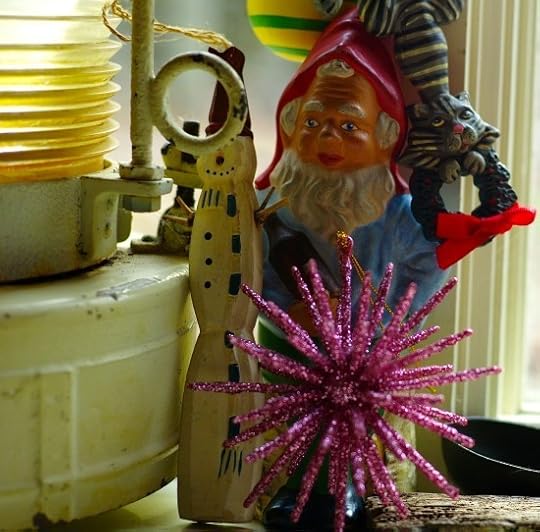
Klaus has discovered the true meaning of Christmas. It is not the gifts, nor the eating, nor a well made cocktail. What Christmas means to Klaus is the gathering of his family and the desire to see good things come from within.
Klaus hails from the Black Forest region of Germany. This is a place where Christmas is celebrated all year long in the form of festive foods like stuffed pork chops, sausages, rib roasts and of course strong drinks to quell the icy winds that flow down from the mountains. Klaus is very familiar with strong drinks, that’s why he is called the Soused Gnome!
On a recent trip to Germany in his little ceramic brain-while dreaming… Klaus visited his uncle. Uncle Franz had concocted a hand-made Vermouth with Beets! Klaus, being the healthy little guy that he is loves root vegetables of all types, especially beets.
Fresh beets are shaved with horseradish into a slurry of strong brandy along with herbs and spices.
Is it uncouth to mix vegetables with liquor? Not if you are the Soused Gnome.
Klaus’s friend Bianca Miraglia from Red Hook, Brooklyn in NY, makes this salubrious hand made Vermouth from natural and sustainable ingredients.
She knows the secrets of the earth. Bianca unlocks these secrets every time Klaus’s little ceramic stomach thirsts out for strong liquor. She knows what it means to seek flavor and character in drinks.
Bianca also holds another secret but Klaus isn’t saying, so I will. It is the secret of Christmas. That the best gifts received are the ones from inside his little ceramic body. The most important part of Christmas isn’t the material objects, but the ones that make him rosy and warm inside from abundant love.
Each time that Klaus imbibes a mouthful of Uncouth Vermouth he is given a liquid driven choice.
Which flavor to choose?
On Klaus’s Christmas list there are several varieties. He is especially fond of the beet flavor woven with eucalyptus, but he’s also taken a shine to the Serrano chili and lavender. The apple mint is lovely in a glass with a bit of seltzer water and a splash of fine bourbon whiskey. Pappy? Pappy? Nah, Pappy is too difficult to find. Klaus will stick with Four Roses instead. Or maybe Klaus would enjoy a splash of Tequila or perhaps some smoky Mezcal to go with Vermouth. All these choices!
The true meaning of Christmas is the gathering of friends and family around the Yule log. Songs will be sung. There might be some yodeling and dancing around the fire. Vermouth is mixed in glasses and thrown down, one after another. Klaus is good at this game. Drinking is what he does best.
Klaus wishes you a very merry Christmas and a Happy New Year.
He wants me to tell you the recipe for his reddish cheeks. A concoction that only Klaus will understand, and you will crave!
Klaus’s Uncouth Christmas slurp!
Ingredients:
Uncouth Vermouth (Beet, Eucalyptus variety)
Botanical Gin like Half Moon Bay from Tuthilltown Spirits in New York State (made from Apples)
Slices of freshly steamed beets muddled in a Boston Shaker with a touch of horseradish (Gold’s works)
Sprigs of dill leaf
Preparation:
To a Boston Shaker, muddle some of the beets with a bit of horseradish to make a nice slurry
Add:
2 oz. Uncouth Vermouth Beet/Eucalyptus Vermouth
2 oz. Botanical Gin
fill the shaker ¾ with ice and shake shake shake shake shake shake (Klaus loves to shake the shaker)
Double Strain into a Martini glass and garnish with a slice of beet and a small sprig of dill
Happy Christmas and to all a good night! Good night Klaus.. Merry Christmas to you and your family in Germany.
December 21, 2012
A Beekman Christmas Goose, via Fanny Cradock.
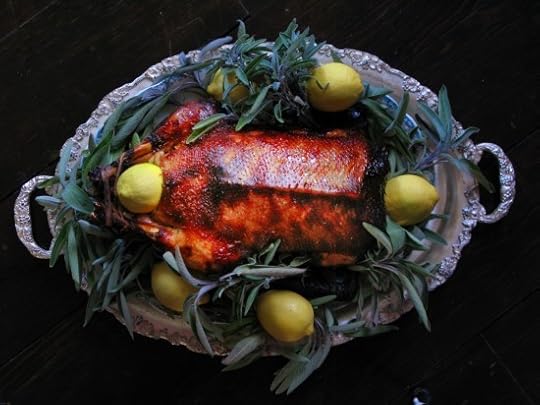
Our Christmas Goose
Thanksgiving means turkey.
Easter means ham.
And Christmas means….?
Many Americans default to turkey again for Christmas, but we sometimes find it uninspiring to cook basically the same big meal twice within the same month.
This year our friend, Jonathan, raised several different kinds of fowl, and offered us one of his geese. We jumped at the chance. Geese are the definitive northern European Christmas main course, (think Charles Dickens’ “A Christmas Carol,”) but are increasingly hard to find in the U.S. Goose meat is very dark and rich, like duck, and can be hard to digest if not cooked correctly. The main goal in cooking goose is to be sure that as much of the fat is drained off as possible, without overcooking resulting in tough meat. (And being sure to reserve the fat, as it’s the preferred fat by most chefs for cooking potatoes.)
We’d never cooked a goose before, and had a little difficulty finding a cooking method that was specific to goose, and not just fowl in general. Because there is so much fat under the skin of geese, it’s often difficult to satisfactorily brown the skin.
That’s when, quite by accident, we stumbled across Fanny Cradock’s method for cooking geese.
We first learned about Fanny Cradock several years ago and fell in love. In that same way that one loves a crotchety old aunt. Cradock was an English cook who rose to fame during the 1950′s and 60′s, and had a rather in inglorious fall from grace in the early 1970′s. She was perhaps the first television “celebrity chef,” – a cross between Martha Stewart, Julia Child, and Cruella Deville. Not exactly the motherly sort. Her chilled salads were usually warmer than her demeanor.
Fanny’s downfall came during a television show in which she ridiculed a poor English housewife who’d won a cooking contest to create a meal for a minor royal. Cradock insulted the woman’s simple pudding dessert to such a degree on national television that viewer outrage caused the BBC to remove her shows from the air. She was rarely seen on television ever again, and died penniless and living in squalor in 1994.
But Fanny knew how to cook a goose. She knew how to get the fat to drain away, and used honey to ensure a brown, crisp skin. (We used our own Rosemary Creamed Honey.) So thank you Fanny, and Merry Christmas. You may have cooked your own goose, but you cooked ours too. And it was delicious.
Watch Fanny in action, causing multiple stab wounds:
Sweet Dreams Christmas Tree
We’re not very “fussy” tree decorators. You’ll probably never find us laboring over something like an “All Paisley Bow Tie Hollywood Regency” theme tree. We like our trees to be fun. Not “textured” or “conceptualized.”
Our main tree stands in the Palladian window of the second floor hallway so that our neighbors can see it driving by. But we also put a tree in our library/living room so that we can enjoy it while sitting by the fire. This year, we decided to decorate it in honor of all the children who have lived in the Beekman throughout the ages.
For the 1950-70′s Beekman children, we started with the old, large colored light strings that we found in the attic. In this age of geometric LED light netting, we’d forgotten how fun these big ole’ bulbs look.
For Beekman kids who lived in the 1920-30′s, the era of the “Good Ship, Lollipop,” we made giant hard candy ornaments, and hung candy canes. (Directions in the slideshow.)
For the wee Victorian Beekmans, we filled up our Victorian Horns of Plenty with popcorn and candies…just like they might have found on their tree. (Directions in the slideshow.)
And for the original Beekman children, who celebrated the very first Christmas in the Beekman Mansion, we decorated with dried orange slices. (Directions in the slideshow.)
Well, maybe it’s a “theme tree” after all.
Except that it’s one that’s more fun than work.


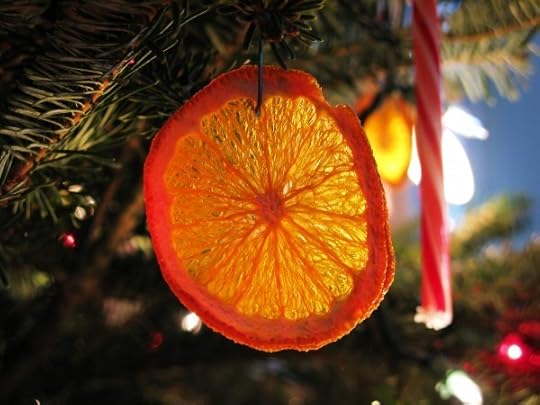
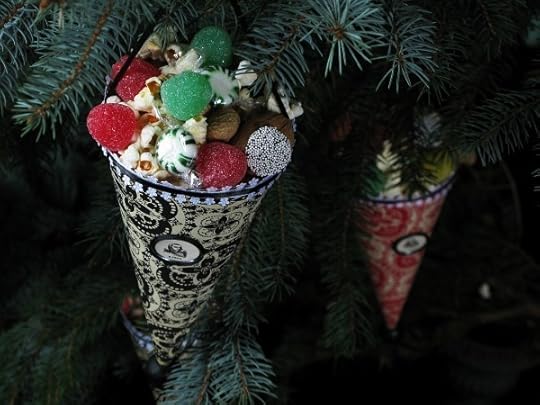





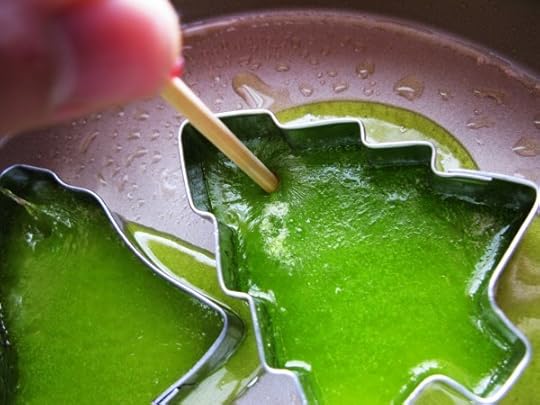


<
>
Sharon Springs Career Day
We recently were invited to take part in Sharon Springs School Career Day where we spoke with Juniors & Seniors about our career(s). We aren’t actually even sure what our career is right now, so we asked our Facebook friends, who mostly told us that we’re “entrepreneurs.” (Among many other funny things.)
Sharon Springs is lucky to have a very small student population, which means a much lower student:teacher ratio. And the school is also home to some truly fabulous teachers. The perfect recipe for a bright future.
The students we met had dreams of becoming everything from conservation officials, to pastry chefs, to writers, to CPAs, to sports managers, to auto repair specialists… some of them taught US about career possibilities. Coming from such a great, tight-knit community, these kids have a great shot at becoming anything they want. And we know they will.
Here are a few pointers we shared:
1. Check all the Boxes, plus a few more. Some career paths are well marked…simply get good grades, get admitted to college, and apply for a job. But with job competition greater than ever, it helps to have a few extra boxes checked. Volunteer at charities associated with the industry you eventually would like to work in. Write letters to potential mentors in your chosen career asking for advice. Start blogging about your career dreams and feature interviews from successful people already in the field.
2. First impressions really do matter. We were impressed to see several students dressed in suits and nice professional clothes. They caught our eye…it makes sense to dress nicely for Career Day, and we appreciated it. As will future employers. This is also true for communication skills. If we receive an email from a potential employee or business partner that has multiple spelling or grammatical errors, we’re likely to pass on it in favor of a well-written communication. (Like everyone, we make spelling errors too…but we always do our best to communicate in a manner that’s professional and easy to understand. Why get passed over for something as silly as not spell-checking?)
3. Actively choose your path. Don’t let it choose you. We’re poster boys for career A.D.D. We each have held many kinds of jobs, starting in our early teens. And even though we’ve had what looks like great strokes of luck (getting our own television show, having a first book published, working with Martha Stewart, getting the chance to compete on The Amazing Race) none of these opportunities would’ve happened if we hadn’t both done the legwork, and taken a risk. Each one of these terrific developments came about because we reached out and networked for them. (And made sure we’d earned the credibility to gain someone’s confidence.)
What career tips would you share with the students in Sharon Springs? Leave them in the comment section below. Let’s make this page a resource for Career Days everywhere.




<
>
December 20, 2012
5 Beautiful Things
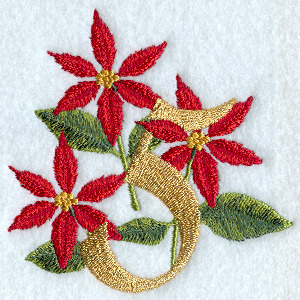
Five Holiday Plants
How many of you have tried your hand at keeping holiday plants, such as poinsettia, cyclamen, amaryllis and Christmas cactus? My guess is, quite a few of you! While they are seasonal favourites, each plant has specific health requirements, which I’ve outlined below, to keep them growing and blooming well past the holidays. I love these plants and have kept many of them year-round. I hope you find the information about them to be useful! Merry Christmas to all of you! I will return in 2013 with new additions to Five Beautiful Things!
POINSETTIA:
Native to Mexico, poinsettias are, without a doubt, the most popular holiday plant in North America and Europe. Millions of these plants are sold each year during the Christmas season. Newer varieties are lasting longer than ever and are also less sensitive to drafts and temperature extremes. However, temperatures above 75 and below 65 are not recommended for the poinsettia, which enjoys moderate, consistent warmth. It likes bright, indirect light most of the time. Direct sunlight should be limited to only four or five hours a day. Water them consistently but modestly; they are not big drinkers but do enjoy evenly moist soil.
The ‘flowers’ of the poinsettia are not flowers at all. The colourful sections of the plant are called bracts, which change colour with a change in light exposure, much as deciduous trees change the colours of their leaves in autumn. Growers of poinsettia place the plant in 14 hours of darkness each day between September and October in order to induce the plant to change the colour of its bracts, which surround the flowers: those tiny, yellow-green buds at the center of the bract formations. They will last as foliage plants for years after you first purchase them if properly cared for, but it is very difficult to get the plant to change colours again without the proper facilities.
AMARYLLIS:
This is one of my favourite plants of all-time. Its tall, slender stalk reaches up to reveal huge, trumpet-like flowers that will take your breath away with their beauty during the holidays. Amaryllis is native to Africa and is one of the few holiday plants that thrive in direct sunlight. A south-facing window with full sun is best for the amaryllis. If you want blossoms for Christmas, plant the bulb in early November. When planting the bulb, be sure to place the soil only halfway to three-quarters of the way up the sides of the bulb’s surface; the bulb requires a few centimeters of exposure. Never completely bury an amaryllis bulb. They prefer small, constricted pots, but enough room to set down roots. Water thoroughly after planting then do not water again until the leaves begin to show. Gradually begin watering again (a small amount once a week is plenty) once signs of growth begin to show. The plant will grow quickly. In a few weeks you will have beautiful blooms. When the blooms fade, cut the stalk. If you wish to preserve the bulb until the following year, allow the leaves to grow throughout the year. The following autumn, cut the leaves and place the bulb in a cool, dark place for two months. Then, replant it and expose it to the sun; you should get a second round out of it!
CHRISTMAS PEPPERS:
These plants are less common now than they once were, replaced by the more exotic amaryllis and cyclamen in recent years. If you do find them, they are usually reasonably priced. The plants’ attractive foliage and colourful fruits and blossoms make cheerful additions to a holiday décor. To prolong their beauty, give the plants bright light and cool temperatures. An occasional mist of water keeps the foliage looking its best. Treat pepper plants as annuals – throw them away when they become unattractive as they are not likely to refurbish their blooms or fruit a second time in a pot. You can dry the peppers and use them as seasoning, but be warned that they are very hot! Both Christmas peppers and Christmas cherries are easy to grow from seed. Plant the seeds in pots in the spring and put them in a sunny spot – even outdoors, if you prefer. Move them inside before the frost and you should have fruits by Christmas.
CYCLAMEN:
Cyclamen is a fussy but lovely addition to a holiday collection of plants. Their flowers are almost angelic as they bob weightlessly from tall, slender stems. They come in a myriad of colours, also: dark pink, light pink, variegated pink, deep red and plain white. They are native to the mountain ranges of the Mediterranean and Asia and like cool environments that simulate the conditions of a forest floor: moist, cool and limited exposure to sunlight. These plants do not have roots, but tubers. As such, they are easily prone to rot. Water them frequently but carefully. Never let the soil dry out but never let it get soggy either. Water them with small amounts at a time two times a week. Keep them in an east, west or north-facing window and make sure to keep them away from dry air vents, fireplaces and heaters.
The flowering stages of cyclamen vary slightly. They are unlikely to bloom a second time in your home, although my grandmother has been blessed with a cyclamen that has never once stopped flowering during a two-year period! You may wish to discard the plant after the flowers have passed, although the foliage is quite nice.
CHRISTMAS CACTUS:
The Christmas cactus is actually not a cactus at all. It is a succulent and therefore requires even moisture throughout the year. It enjoys bright light but not direct sun. An east or west facing window is best. The plant will begin to bud in mid-November and flowers could last as long as three months with proper care. I’ve even had summer blooms on my plant. Many people complain that their Christmas cactus never blooms again. This is likely because they don’t realize that the plant must be subjected to minimal exposure to light and no water for at least one month prior to the time you wish the plant to bloom. The plant will always bloom after a period of stress.
If you want blooms for the holidays, remove the plant from its usual spot and place it in a dark corner for one month, neglecting to give it water during this period. Once the month has passed, bring the plant back to its usual bright spot and gradually begin watering it again. Within a few weeks, you will see numerous buds begin to appear. Christmas cactus can be forced to bloom at any time during the year using this method of stress, but be sure not to get too greedy or the plant will give up. It requires consistency most of the time. As the blooms fade, remove them; this may further the flowering stages. For the rest of the year, keep the plant happy with even moisture and bright light.

Andrew Ritchie is the creator of Martha Moments, a blog devoted Martha-Stewart related content and her community of supporters. He lives and works in Toronto, Canada, and has been a longtime friend of Brent & Josh, Beekman 1802 and Sharon Springs. Each week he’ll scour the world (wide web) to find the 5 most beautiful things to inspire you. Follow Andrew on Pinterest.
December 19, 2012
Gartending: Blame it on Rio

“You have to learn the rules of the game. And then you have to play better than anyone else.” –Albert Einstein
I wanted to lead off this week’s adventure with this quote from the Beekman Boys Facebook page. If you didn’t know, The Beekman 1802 Boys just won the Amazing Race on television. I don’t normally watch flashy reality shows but this one was much different. The characters were everyone types from all over the country except for one couple. The Beekman Boys. My friends, Brent and Josh.
I started writing for them after they did a book signing at Williams-Sonoma in Short Hills, NJ. I introduced myself as a cocktail mixologist/author and they asked me if I’d like to write for them.
The rest is lovely histories for myself and of course my alter-ego/gnome, Klaus, the Soused Gnome.
Perhaps you’ve seen his fan page on Facebook?
He’s a good little guy who brings a smile to most. And this brings me back to the initial quote, “You have to learn the rules of the game.” I’ve discovered that if I can make just one person smile and share in the passion that is Klaus, then I’m truly a success. Certainly within Klaus’s tiny ceramic heart he is living a dream.
I often wonder what his life was like before I acquired him? I wonder if his former owners brought him around the world?
We’ve been to many places together in the past few months, Oregon, France, Ohio-twice, the Kentucky Derby, Charleston and of course New York. It’s been busy for the little guy. Even with all this traveling, he still stays very thirsty.
Klaus loves New York City and he loves going to new and exciting cocktail bars. One of these is named Milk & Honey. It used to be way downtown. Now- the coming weeks are ahead of us and with the rush to the New Year, Milk & Honey will soon be open. The new address is 30 East 23rd Street in NYC. It’s no longer in a tough neighborhood- you will feel comfortable visiting this new temple to the cocktailian arts because it’s located in a fabulous shopping district of Manhattan!
Avuá Cachaça invited Klaus to the soon-to-be-reopened Milk & Honey for the pre-launch of their expressive liquors. Klaus was very thirsty for some delicious cocktails that spoke clearly of the passion of Brazil.
What Klaus would do for the chance to visit Rio in the winter? I shudder to imagine. It’s summer in Brazil and the drink of choice is Cachaça mixed with lime and sugar.
Klaus should be so lucky.
Summer in Rio Cocktail (will smash even the most robust drinker)
(Each recipe makes two drinks)
Ingredients:
Avuá Cachaça
Blood Orange rounds
Victoria’s Kitchen Almond/Coconut Water
Hand cut ice
Fresh lime juice
Simple Syrup
Instructions:
To a Boston Shaker filled ¾ with ice add:
4 oz. Avuá Cachaça
6 oz. Victoria’s Kitchen Almond/Coconut Water
1 oz. Fresh lime juice
1 oz. or to taste Simple Syrup
1 oz. Blood Orange juice
Shake Shake Shake Shake Shake
Strain into a short rocks glass with one cube of hand cut ice
Garnish with Blood Orange ½ rounds
Prepare for a plane ticket to Rio!
Gingerbread Men Sandwiches with Frozen Orange Custard

These little guys are a combination of two classics…gingerbread cookies and ice cream sandwiches.
Everyone thinks that Holiday Desserts should be warm and cozy, but these frozen gingerbread men sandwiches can be a refreshing treat following a heavy winter meal. We made an Orange Frozen Custard to fill ours. The citrus flavor brightens the spicy cookies.
To make these icy treats, simply make small to medium sized gingerbread men and frozen custard (recipes below.) After making your custard in your ice cream maker, while it’s still in the soft serve stage, spread it on a foil lined baking pan. It can be a thick layer or thin, depending on how “stuffed” you want your finished gingerbread men to be.
Cover the baking pan with plastic wrap, keeping the top as smooth as possible, and freeze overnight till it’s frozen solid. Using the same cookie cutter that you used for your gingerbread men, cut out “ice cream gingerbread men.” Assemble the cookies with the cut out ice cream shape between two cookies (flat side of cookies facing inward.)
Work quickly, of course so that the frozen filling keeps its shape, and keep assembled cookie sandwiches in the freezer till ready to serve. The cookies and frozen custard can be made ahead of time, but it’s best to assemble them right before serving so that the cookies don’t get too soft.
(If you don’t have time to make your own ice cream/custard filling, purchase ice cream from the store, allow to soften, and spread in baking pan according to above directions.)
HARD GINGER BREAD
(from The Presidential Cookbook, 1896)
“Stir to a cream one cupful of butter and a half a cupful of brown sugar; add to this two cupfuls of cooking molasses, a cupful of sweet milk, a tablespoonful of ginger, a teaspoonful of ground cinnamon; beat all thoroughly together. Beat into this two cups of sifted flour, then a teaspoonful of soda, dissolved in a spoonful of water, and last, two more cupfuls of sifted flour.”
Roll to a thickness of ¼” on a lightly floured surface. Bake at 350 for 8-12 minutes.
ORANGE FROZEN CUSTARD
(This recipe uses raw eggs. Pregnant women, the elderly, children and those with compromised immune systems should use all safety precautions.)
7 eggs
2 C milk
1 C sugar
2T honey
½ t salt
2 C heavy Cream
¼ C orange juice
zest of two oranges
In room temperature medium saucepan, whisk together eggs, milk, sugar, honey and salt. Slowly heat to no more than 155. Eggs begin to curdle at 160-170 and the trick is to get them right up to this point, but no further. Cool quickly by setting pain in ice water. (We do this in the sink.) Whisk in cream and orange juice. Do not add zest. Chill for several hours. Freeze according to the directions on your ice cream maker. Add the zest in the last minutes of churning so that it doesn’t clump at the bottom.
Spread soft serve mixture in foil lined baking pan, cover with plastic wrap, and freeze.
December 18, 2012
This Will Go Down In History
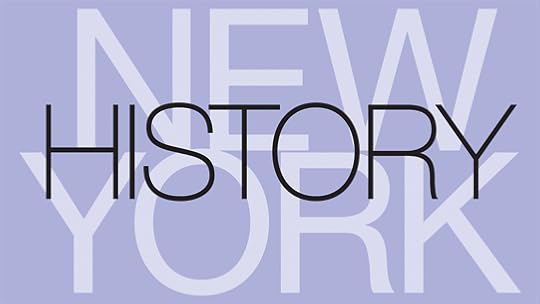
The New York State Historical Association
Cooperstown, located in Otsego County, some 23 miles to the southwest of Sharon Springs (not the way the crow flies!), is known far and wide for various attractions. The National Baseball Hall of Fame and Museum is located there, drawing many tourists. In an earlier blog we wrote about the successful Glimmerglass Festival, located eight miles north of the town at the other end of Otsego Lake. And of course there is Cooperstown’s historical connection to the Cooper family.
Judge William Cooper moved to the region in 1790 from New Jersey and founded the Village of Otsego at the foot of Otsego Lake, part of the Cooper Patent. (Judge William Beekman, his contemporary in the neighboring county of Schoharie built the Beekman Farm.) His son James Fenimore Cooper, aged one at the time, grew up to be the novelist famous for the Leatherstocking Tales. William Cooper died in 1809; in 1812, the village of Otsego was named Cooperstown in his honor. In 1813, James Fenimore Cooper, who had been living in Westchester County since his marriage two years before, returned to Cooperstown to live at Fenimore Farm. On the site of his former farmhouse – now situated along State Highway 80, on the west side of lake, one mile north of the Village of Cooperstown – stands the Fenimore Art Museum. The museum is part of the New York State Historical Association (NYSHA), a private, non-governmental organization serving as a wonderful resource for any of us interested in history.
The New York State Historical Association was founded in 1899 by group of New Yorkers, the first meeting held in the village of Lake George at the southeastern base of the Adirondack Mountains. NYSHA’s mission was to create a center of historical studies including a museum and library, provide lectures and publications, and to locate markers at places of historic interest.
For two decades and a half, NYSHA was without a permanent home. In 1926, the industrialist and philanthropist Horace Moses donated the Hancock House in Ticonderoga, New York to NYSHA – the structure a replica of John Hancock’s house in Boston – along with an endowment to help cover the organization’s operating costs. In 1939, Stephen Carlton Clark, Sr., offered NYSHA a new home – one of his family’s properties, a neo-Georgian structure built in 1932 on the site of the former Cooper farmhouse and named the Fenimore House for the historical connection. Clark, the grandson of Edward Clark, a founding partner of the sewing machine makers I.M. Singer & Co. (now known as the Singer Company), was a renowned art collector and a founding trustee of the Museum of Modern Art in New York City. His vision was that the Fenimore House be used as both an administrative headquarters for NYSHA and as a museum and library. Stephen Clark also contributed to Cooperstown as a tourist and cultural center through his involvement with the building of the Otesaga Resort Hotel and the founding of National Baseball Hall of Fame and Museum.
NYSHA’s Fenimore House Museum – renamed the Fenimore Art Museum in 1999 – is known for its American folk art collection, including paintings, carvings, decorated wares, trade signs, quilts, ship figureheads, weathervanes, and cigar-store figures. Its fine art collection is also extensive, including many works by painters of the Hudson River School. The Smith and Telfer Photographic Collection consists of 60,000 photos documenting the history of Cooperstown and its people. The museum also has a collection of life masks of famous Americans, such as Thomas Jefferson.
In 1995, a 18,000-square-foot wing was added to the Fenimore House for the Eugene and Clare Thaw Collection, works from many Native North American peoples, including those of the Northwest Coast, Southwest, Woodlands, Plains, Southwest, California, Great Basin, and Arctic. The Thaws assembled the pieces with an eye for their powerful aesthetic and to prove that Native American artworks are equivalent to those of any culture. The collection has been part of touring exhibitions and programs sponsored by the museum, in many instances with the involvement of Native peoples.
Earlier, in 1968, a separate structure was built next to the Fenimore House for the NYSHA Research Library. Over the years, since 1899, the library has assembled extensive collections, relating especially to New York State and colonial history and culture, folklore, Native American studies, 19th-century American art history, and museum studies. The Special Collections Department has a wide variety of materials, including rare books, manuscripts, archival collections, maps, broadsides, and ephemera. The Research Library has also been a genealogical source for many regional inhabitants. Wayne Wright, the Head Librarian at NYSHA, states: “The library’s local history and genealogical resources are extensive for a number of New York counties, especially Otsego, Schoharie, Montgomery, Herkimer, and Chenango.”
In 1919, NYSHA began its publication of The Quarterly Journal of the New York State Historical Association, with scholarly articles on the history of New York State. The name was changed to New York History in 1932. In 1984, NYSHA also began publication of a popular history magazine, Heritage, in order to reach a broader audience.
With so much to offer, NYSHA has been a perfect location as an educational center. In 1964, NYSHA and the State University of New York College at Oneonta formed a partnership to create the Cooperstown Graduate Program, offering a two-year course of study for a Master of Arts degree in History Museum Studies (until 1979, also offering a degree in American Folk Culture, and, until 1987, also offering a degree in Conservation of Historic and Artistic Works). The Research Library has kept a collection of the student theses about local history in the Archive of New York State Folklife.
Across the road from the Fenimore Art Museum and Research Library – on the grounds of what was once James Fenimore Cooper’s farmstead and redeveloped as a farm in the 20th century by Stephen Carlton Clark’s brother Edward Severin Clark – is NYSHA’s sister organization, The Farmers’ Museum. It includes the Main Barn, housing offices and exhibits; the working Empire State Carousel and accompanying Country Fair; the Historic Village, comprising 23 buildings of the late 18th and early 19th centuries gathered from around New York State, such as a blacksmith shop and smokehouse; and the Lippitt Farmstead, a living example of how a farm would have operated in the mid-19th-century. The Farmer’s Museum has some 23,000 artifacts relating to early farming.
The region – and beyond! – is lucky to have this center of historical activity, the New York State Historical Association. For any of you visiting Sharon Springs with an eye for history, take in what Cooperstown and NYSHA have to offer as well. Wayne Wright, NYSHA’s Head Librarian, further states: “During my three-and-a-half decades at the Historical Association, I’ve witnessed firsthand its importance to the community at large in the dissemination of knowledge, the preservation of artifacts, and the education of individuals pursuing careers in museum studies. I’m happy to report that the pursuit of history endures!”
The History Boys are
Chris Campbell has made his permanent home in Cherry Valley, NY. The Campbell family dates back to 1739 in this town, situated about eight miles from Sharon Springs. Some family members were captured by Tories and Iroquois allies in the Cherry Valley Massacre of 1778 during the American Revolution and taken to Canada, released two years later in Albany as part of a prisoner exchange. Chris is a rare book and map collector and has had a lifelong interest in history, especially relating to upstate New York and colonial land patents. He was the founder and first chairman of the Cherry Valley Planning Board and has worked as a surveyor and realtor as well as a researcher for the Otsego County map department. His hobbies include Ham radio.
Carl Waldman, also living in Cherry Valley, is a former archivist for the New York State Historical Association in Cooperstown. He is he author of a number of reference books published by Facts On File, including Atlas of the North American Indian and Encyclopedia of Native American Tribes, both originally published in the 1980s and both in their third editions. He is the co-author of Encyclopedia of Exploration (2005) and Encyclopedia of European Peoples (2006). Carl has also done screenwriting about Native Americans, including an episode of Miami Vice entitled “Indian Wars” and the Legend of Two-Path, a drama about the Native American side of Raleigh’s Lost Colony, shown at Festival Park on Roanoke Island in North Carolina. His hobbies include music and he works with young people in the Performance and Production Workshops at the Cherry Valley Old School.
Carl has recently published an ebook through Alva Press, Streetscape: A Jake Soho Mystery
December 13, 2012
Colin, You’re AMAZING!!!
We’ve received over 8000 congratulation wishes so far, and we’ve read every single one. Going through them is like winning the race all over again. They each made us feel very special, and we thank you.
But today, we want to help someone else feel special.
Below is one of the first letters we received this week after winning the Amazing Race. It comes from a mother with a son named Colin:
“I’m sure you guys are way too busy to read this, but I want you to know how inspirational you two are to my 12 year old son. He is gay and is dealing with bullying and harassment in middle school. It’s so hard to see him going through this, and sometimes the “It Gets Better” message is lost on a 12 year old who feels that middle school will never end…We cheered you on every Sunday night and agonized every time you had difficulties. My son was so incredibly thrilled when you two won last night (as was I!). Thank you for helping him see that not only DOES it get better, it gets AMAZING.” (Permission was granted by both Colin and his mother to reprint letter and use names.)
We were called the “Ultimate Underdogs” on the Amazing Race. And when we hit the finish mat, we urged everyone who feels like they’re down-and-out to “keep going, try as hard as you can, eventually someone will help you – and you will win.”
Colin, we know that you’re doing your best, and working as hard as you can in school. We shared Colin’s mom’s note with our fellow Amazing Racers – who have also all been underdogs for various reasons at some point in their lives.
And here is the entire Amazing Race 21 team’s message to you, Colin!…







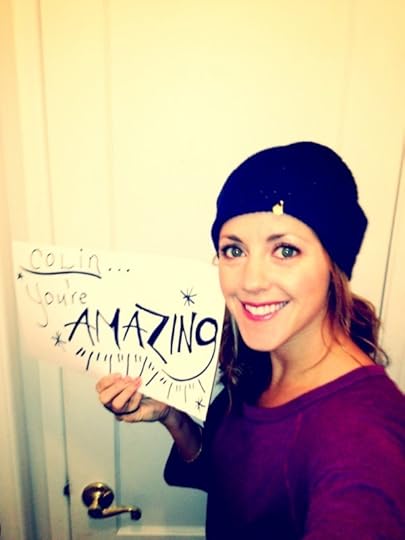







<
>
Who is the Amazing Underdog in your life? Send them a word of encouragement in the comment section below.
5 Beautiful Things
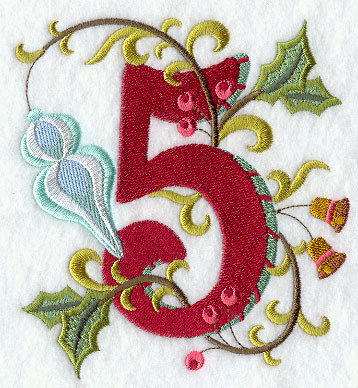
Christmas at Longwood Gardens
This time of year, many towns and cities around the United States and Canada enhance their public spaces with Christmas decorations. Tourist attractions, too, are decked out in holiday finery: garlands, twinkle lights, wreaths and Christmas trees. At Longwood Gardens, just 30 miles outside of Philadelphia, the Christmas tradition is truly one to behold.
Originally founded as a Quaker farm in the 1700s, Longwood Gardens is one of the most illustrious public gardens in the United States today. It began as an arboretum and was developed in the 1850s into an elaborate showcase of gardens by the property’s new owner Pierre Du Pont, an industrialist who was very interested in conservation, farming, gardening and landscape design.
The gardens were opened to the public in the 1940s and have been a Pennsylvania landmark ever since. Their Christmas displays are a must-see each year. I urge you to visit their website to read more about the colourful history of this place and to potentially plan a visit to see the Christmas displays, which will be up until the 6th of January. Longwood Gardens is located on US Route 1, about 3 miles northeast of Kennett Square, PA.

All photos courtesy of Longwood Gardens.
Andrew Ritchie is the creator of Martha Moments, a blog devoted Martha-Stewart related content and her community of supporters. He lives and works in Toronto, Canada, and has been a longtime friend of Brent & Josh, Beekman 1802 and Sharon Springs. Each week he’ll scour the world (wide web) to find the 5 most beautiful things to inspire you. Follow Andrew on Pinterest.



